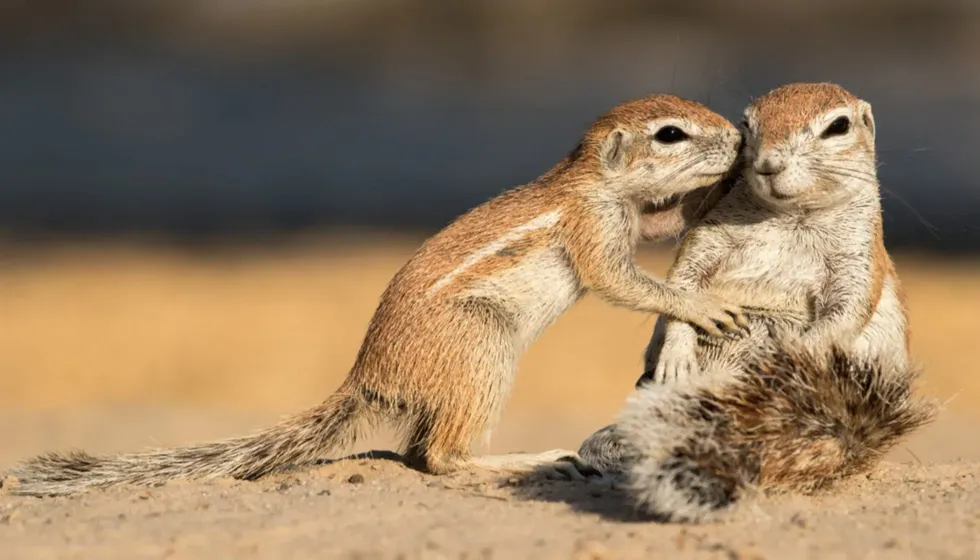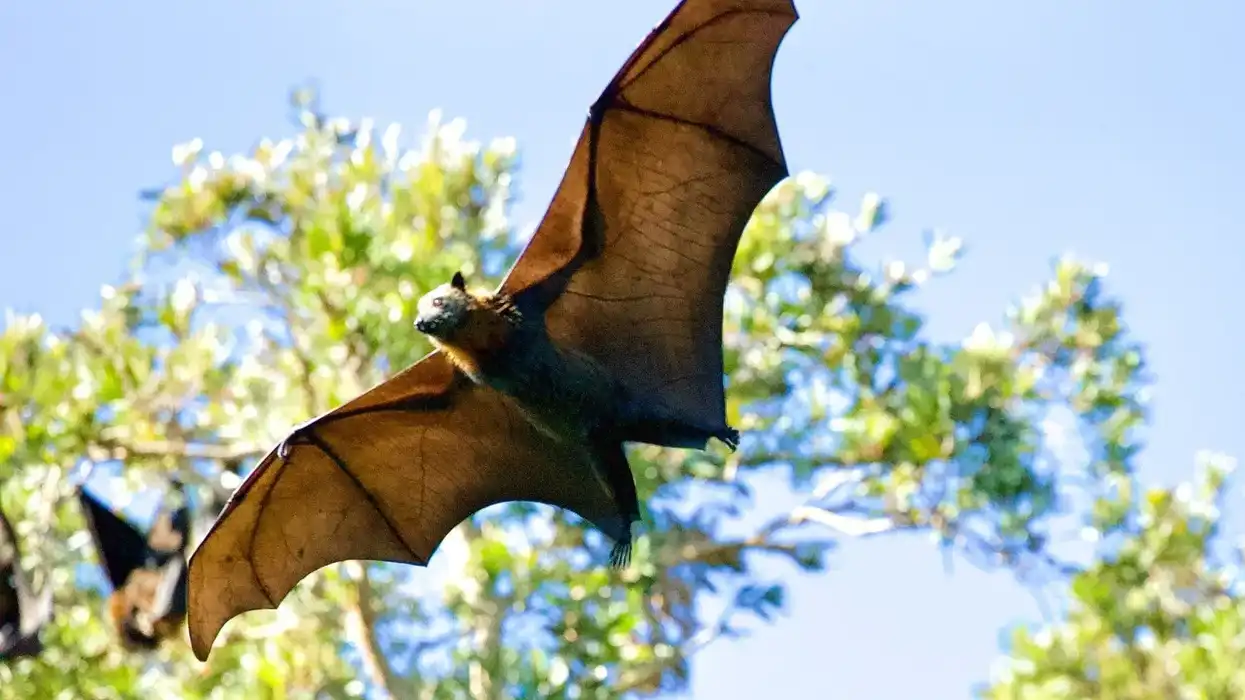The Cape ground squirrel (Xerus inauris) is a species endemic to South Africa. They are also known as the South African ground squirrel or the fan-tailed squirrel. Xerus inauris is best known for forming gender-based groups.
Adult males live separately in groups of about 19 individuals. Adult females live in groups with young ones that need nurturing.
These animals are quite adapted to their desert life, and the Cape ground squirrels use their bushy tail as portable umbrellas to protect them from the sun. The IUCN Red List has put this species in the Least Concern category. The Xerus inauris can eat bulbs, seeds, grasses, and insects.
The Cape ground squirrels are active during the day and groom or bask in the sun first thing in the morning. The Xerus inauris can breed throughout the year and does not have a specific breeding season.
Females can have more than one litter of pups in a year. After breeding, the gestation period of the females lasts for about 45 days or at most 49 days.
These animals can give birth to a litter of about one to three pups. The male Cape ground squirrels do not aid in raising the pups, and adult females take care of parental duties alone. Female squirrels isolate themselves in the burrow during pregnancy and will emerge only after giving birth.
The young pups undergo weaning and can become independent in a period of about 52 days. Females mature in 10 months, while males take about eight months.
Do you find the South African ground squirrel adorable? Scroll down to read more amazing facts about this animal. If you love squirrels, then you will absolutely love reading about the Indian palm squirrel and Japanese squirrel.
Cape Squirrel Interesting Facts
What type of animal is a Cape squirrel?
The Cape ground squirrel (Xerus inauris) is a species of squirrel that is endemic to South Africa. They are also known as the South African ground squirrel or the fan-tailed squirrel. These squirrels can be identified by their cinnamon-colored fur and two bands on the tail.
What class of animal does a Cape squirrel belong to?
The South African ground squirrel, Xerus inauris, belongs to the class of mammals from the Xerus genus of the Sciuridae family. The term Xerus means a genus of the ground squirrel with coarse hair and a long tail, resembling the prairie dogs in their habits or behavior.
How many Cape squirrels are there in the world?
The population size of the Cape ground squirrel is unknown. However, their population is stable and not threatened at all. These animals are also considered agricultural pests in some areas of Africa.
Where does a Cape squirrel live?
The South African ground squirrels are mainly found in the grasslands of South Africa. This includes Etosha National Park, southwestern Kalahari in Botswana, Lesotho, and Namibia. The Xerus inauris can be found at an elevation of about 1968-3937 ft (600-1200 m) in the Kalahari desert.
What is a Cape squirrel's habitat?
The habitat of a Cape squirrel, Xerus inauris, is mainly around arid or semi-arid grasslands and velds with hard ground. The Xerus inauris squirrels will also inhabit flood plains, agricultural areas, and scrub along with pans.
Who does a Cape squirrel live with?
The Cape ground squirrel, Xerus inauris, is known for its social group behavior. These animals usually live in clusters of groups that are mostly divided by gender. The males live in groups of 19 individuals. Two to three adult female squirrels form groups with offsprings and around nine to-be adults of either gender.
How long does a Cape squirrel live?
The average lifespan of a South African ground squirrel is around 11.5 years.
How do they reproduce?
The South African ground squirrel is polygamous, which means both genders can have multiple partners in one season. There is no particular breeding season for the squirrel as such, and breeding lasts throughout the year.
Females can have more than one litter of pups in a year.
After reproduction, female squirrels have a gestation period of 42-49 days and usually give birth to one to three offspring. After giving birth, the female tends to isolate herself in the burrow and rejoin the group later.
The pups can open their eyes in 35 days and can leave the burrow after 45 days. Female squirrels tend to stay in the same group after maturity, while males leave to become independent and join all-male groups.
Males reach sexual maturity at eight months of age, and female squirrels reach sexual maturity at 10 months of age.
The pups become independent in 52 days and reach the size of an adult in 153 days. The young pups will go through weaning at 52 days of age and can eat solid food only after they emerge from the burrows.
What is their conservation status?
According to the IUCN Red List, the conservation status of a Cape ground squirrel from South Africa is at Least Concern. This means that the population of Xerus inauris is not endangered and is relatively stable year-round.
Cape Squirrel Fun Facts
What does a Cape squirrel look like?
The South African Cape squirrels have short cinnamon fur on their back and have white fur on the face, ventral sides, underbelly, and sides of the neck. The skin under the coat is usually black, and each side of the body has a white stripe that runs from the shoulder of the squirrel to the thigh.
The tail of Xerus inauris has two black bands on the base and is covered with white hair.
How cute are they?
The South African ground squirrel is very cute, and if you see their photos, it looks as if they're politely asking for a favor. Their eyes are round and black, with short brown fur on the body of this animal.
These Xerus inauris squirrels are also very small and enjoy dust bathing or wrestling together.
When these animals are feeling hot under the sun, they tend to use their tails as umbrellas to shade themselves. Although the Xerus inauris is shy, it is very entertaining to observe this adorable species.
How do they communicate?
The Cape ground squirrels mainly communicate using sound. They have loud calls or high-pitched screeches to warn against threats or predators. Xerus inauris also have different sounds while playing or while communicating with their mother. Cape ground squirrels can also communicate using smell.
How big is a Cape squirrel?
The average length of a Cape ground squirrel can range from 16.6-18.7 in (424-476 mm). The Xerus inauris is about twice the size of a small eastern gray squirrel.
How fast can a Cape squirrel run?
There are no studies that have estimated the speed of Cape ground squirrels from South Africa. The average speed of squirrels as a species overall is about 20 mph (32 kph).
How much does a Cape squirrel weigh?
The average weight of a South African ground squirrel can range from 15-22.8 oz (423-649 g). The newborn pups usually weigh 0.7 oz (20 g).
What are the male and female names of the species?
No specific male or female names have been assigned for the Xerus inauris species. Male and female South African ground squirrels can usually be differentiated according to size.
What would you call a baby Cape squirrel?
Baby Cape ground squirrels can be called pups.
What do they eat?
The Cape ground squirrels usually rely on bulbs, grasses, insects, seeds, herbs, or nuts for food. They are mainly omnivores and are not very picky with their diet. The main predators of the South African ground squirrel species are black-backed jackals, puff adders, and monitor lizards.
Are they dangerous?
Cape ground squirrels are a totally harmless species and really interfere with human beings. They are known to be agricultural pests in some areas. South African ground squirrels can lead to crop damage and the spread of rabies.
Would they make a good pet?
South African ground squirrels are very shy and prefer staying in the wild. The Xerus inauris will usually keep its distance from humans and will be difficult to tame.
Did you know...
The Cape ground squirrels don't usually stray too far away from their burrows. Research showed that a 7534 sq ft (700 sq m) area would have about 60 burrows, each with a distance of 656.1 ft (200m). These squirrels will not wander too far off from the home range or their burrows.
The Cape ground squirrels have a mutually beneficial relationship with the meerkats. The squirrel provides their burrows as shelter, while the meerkats alert the squirrel with a high-pitched squeal whenever they spot predators. The meerkats and yellow mongooses use the burrows as a hiding place year-round, mostly to regulate their body temperature from the scorching heat.
The Cape ground squirrels have a set morning routine. Xerus inauris will wake up early in the morning, groom themselves and then bask in the sun.
After looking for food, they leave afternoons for socializing and grooming. Despite having a social order of dominance, the male squirrels often groom each other. Females may isolate themselves post gestation period and give birth to the young pups.
The squirrels use positions of the sun throughout the day as an orientation marker that tells them to hide or recover their food.
How does a Cape ground squirrel survive in the desert?
Cape ground squirrels are very well adapted to desert life. The long bushy tail of a Cape ground squirrel is used to distract the predators when they approach the squirrel.
Xerus inauris can also use their tail to shade themselves from the sun. Another factor that helps them survive in a desert is their burrows.
The burrows help escape the heat and control body temperature. They also prove to be an excellent hiding spot from predators. Xerus inauris are very vigilant and have sensitive ears, aiding them in capturing any movement from threats.
Since they keep coming back and forth from their burrows, scientists have given it the name of 'shuttling.' The squirrels can usually obtain moisture from the food they eat and can survive high temperatures.
Does Africa have squirrels?
Yes! The African continent has beautiful and expansive wildlife that attracts people all around the world. Squirrels have lived in the African continent for 20 million years. The most common squirrel species include Cape ground squirrel, African tree squirrel, Smith's bush squirrel, red bush squirrel, mountain ground squirrel, African giant squirrel, sun squirrel, and Lady Burton's rope squirrel.
Here at Kidadl, we have carefully created lots of interesting family-friendly animal facts for everyone to discover! Learn more about some other mammals from our Syrian hamster facts or mountain beaver facts pages.
You can even occupy yourself at home by coloring in one of our free printable cape squirrel coloring pages.









